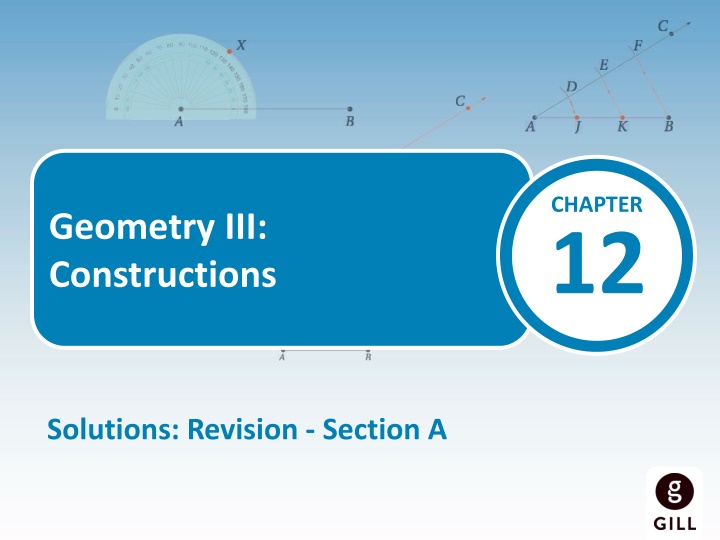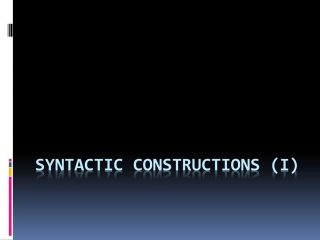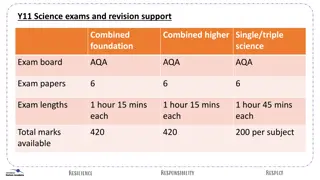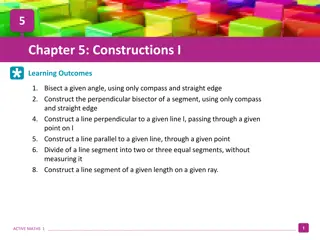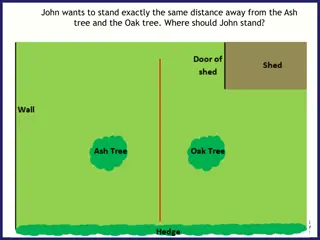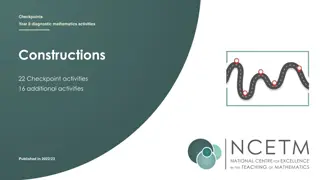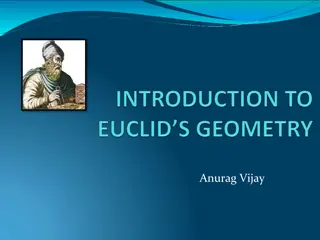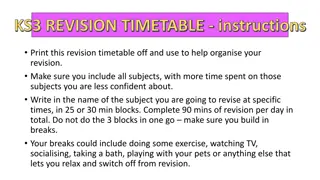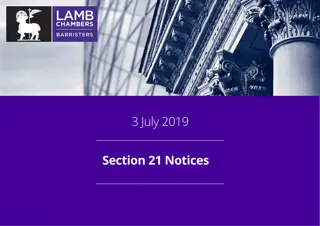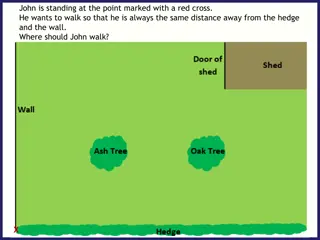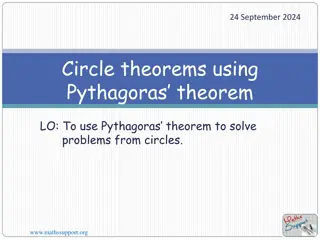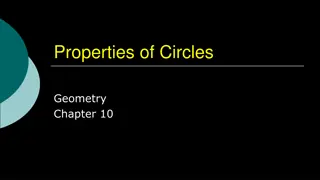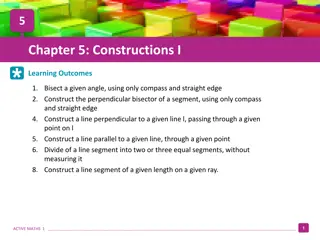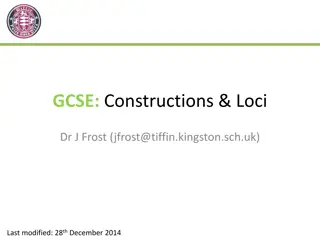Geometry Constructions Revision Solutions Section A
This chapter provides step-by-step instructions and solutions for constructing different geometric shapes like triangles and rectangles. Detailed guidelines are given to construct triangles with specific side lengths and angle measurements, as well as an equilateral triangle. The content also covers constructing a rectangle with specific side lengths. Each exercise is accompanied by clear diagrams illustrating the construction process.
Download Presentation

Please find below an Image/Link to download the presentation.
The content on the website is provided AS IS for your information and personal use only. It may not be sold, licensed, or shared on other websites without obtaining consent from the author.If you encounter any issues during the download, it is possible that the publisher has removed the file from their server.
You are allowed to download the files provided on this website for personal or commercial use, subject to the condition that they are used lawfully. All files are the property of their respective owners.
The content on the website is provided AS IS for your information and personal use only. It may not be sold, licensed, or shared on other websites without obtaining consent from the author.
E N D
Presentation Transcript
CHAPTER 12 Geometry III: Constructions Solutions: Revision - Section A
12 Revision and Exam Style Questions: Section A 1. Construct a triangle ABCwith |AC| = 10 cm, |BC| = 8 cm and |AB| = 6 cm. What is the measure of the angle ABC? Steps: 1. Draw a line segment [AC] = 10 cm 2. With compass point on A and compass width = 6 cm draw an arc. 3. With compass point on C and compass width = 8 cm draw an arc. 4. Mark the intersection of the arcs B. 5. Join B to A and C to form the required triangle. | ABC| = 90
12 Revision and Exam Style Questions: Section A 2. Construct a line segment [RS] of 7 cm. Construct the perpendicular bisector of [RS]. Steps: 1. Draw [AB] = 7 cm 1 2[AB] 2. With compass point on A and compass width greater than draw an arc. 3. Keeping the compass width, the same and the point of the compass on B draw an arc. 4. Join the intersection points of the arcs. |AM| = 3 5 cm |BM| = 3 5 cm |AM| = |BM|
12 Revision and Exam Style Questions: Section A 3. Construct a rectangle, ABCD, where |AB| = 7 cm and |BC| = 4 cm. Steps: 1. Draw [AB] = 7 cm 2. At B draw a ray perpendicular to [AB] 3. With compass point on B at compass width = 4 cm draw an arc on the ray. Mark the point of intersection C. 4. Repeat steps 2 and 3 at A and mark point D. 5. Join D to C to form required rectangle.
12 Revision and Exam Style Questions: Section A ABCis a triangle. | ABC| = 78 , |AC| = 7 cm and | BAC| = 43 . Construct this triangle. 4. | ABC| + | BAC| + | ACB| = 180 Sum of angles in a triangle add to 180 | ABC| = 78 given | BAC| = 43 given 78 + 43 + | ACB| = 180 121 + | ACB| = 180 121 + | ACB| 121 = 180 121 Subtract 121 from both sides | ACB| = 59
12 Revision and Exam Style Questions: Section A ABCis a triangle. | ABC| = 78 , |AC| = 7 cm and | BAC| = 43 . Construct this triangle. 4. Steps: 1. Draw [AC] = 7 cm 2. With protractor at A measure | BAC| = 43 3. Calculate | ACB| = 180 (43 + 78 ) = 59 4. With protractor at C measure | ACB| = 59 5. Mark the point of intersection of the arms of the angles as B to form required triangle.
12 Revision and Exam Style Questions: Section A 5. Construct an equilateral triangle with sides of length 6 cm. |AB| = 6 cm |BC| = 6 cm |AC| = 6 cm Steps: 1. Draw [AC] = 6 cm 2. With Compass point on A and compass width = 6 cm draw an arc. 3. With compass point on C and compass width = 6 cm draw an arc. 4. Mark the intersection of the arcs B to from required triangle.
12 Revision and Exam Style Questions: Section A 6. Construct a parallelogram, ABCD, with sides |AB| = 5 cm and |BC| = 7 cm and (i) | ABC| = 80 . Steps: 1. Draw [AB] = 5 cm. 2. With protractor at B measure an angle = 80 3. With compass point at B and compass width = 7 cm draw an arc on the angle arm. Mark point C. 4. Place the side on the set square on [BC] and slide along a straight edge to create a parallel line [AD]. 5. Join D to C to form the parallelogram.
12 Revision and Exam Style Questions: Section A (ii) What is the measure of BAD? 6. Opposite angles in parallelogram are equal. | ABC| = | ADC| = 80 Sum of all angles in a parallelogram = 360 | ABC| + | ADC| + | BAD| + | BCD| = 360 80 + 80 + | BAD| + | BCD| = 360 160 + | BAD| + | BCD| = 360 | BAD| + | BCD| = 200 (Subtract 160 from both sides) | BAD| = | BCD| (Opposite angles) | BAD| = 200 2 = 100
12 Revision and Exam Style Questions: Section A Construct a triangle XYZin which |XY| = 10 cm, |XZ| = 6 cm and | ZXY | = 50 . All construction lines must be clearly shown. 7. (i) Steps: 1. Draw [XY] = 10 cm. 2. At X measure | ZXY| = 50 3. With compass point at X and compass width = 6 cm draw an arc on the angle arm. 4. Mark the intersection of the arc and the arm Z. 5. Join Z to Y to form the required triangle.
12 Revision and Exam Style Questions: Section A (ii) Show how to bisect XYZwithout using a protractor. 7 Steps: 1. [XZ] and [XY]. With compass point on X and any width draw an arc that intersects 2. intersection of the arc and [XZ] and draw an arc. Keeping the compass width, the same put the point on the 3. the arc and [XY] and draw an arc. Keeping the compass width, the same put the point on the intersection of 4. Mark the intersection of these arcs G 5. Join X to G to form the angle bisector. | ZXG| = 25 | YXG| = 25
12 Revision and Exam Style Questions: Section A Construct a right-angled triangle PQR, where | QPR| = 42 , |PQ| = 8 cm and | RQP| = 90 . 8. Steps: 1. Draw [PQ] = 8 cm 2. With protractor at Q draw | RQP| = 90 3. With protractor at P draw | QPR| = 42 4. Mark the intersection of the angle arms as R to form the required triangle.
12 Revision and Exam Style Questions: Section A 9. Construct, without using a protractor or set square, an angle of 60 . Hence, construct, on the same diagram, and using a compass and straight edge only, an angle of 30 . Steps: (i) 1. Draw a line segment [AB]. 2. With compass point at A draw an arc through B. 3. With compass point at B draw an arc through A. 4. Mark the intersection of these arcs C. 5. Join C to A. | CAB| = 60
12 Revision and Exam Style Questions: Section A 9. Construct, without using a protractor or set square, an angle of 60 . Hence, construct, on the same diagram, and using a compass and straight edge only, an angle of 30 . Construct 30o (ii) We can simply bisect the 60o angle to construct a 30o angle. Steps: 1. [AB]. With compass point on A and any width draw an arc intersecting [AC] and 2. Keep compass width the same and point on the intersection of the arc and [AC] and draw an arc. 3. Repeat step 2 on [AB]. 4. Mark the intersection of these arcs G 5. Join A to G to form the required bisector.
12 Revision and Exam Style Questions: Section A 9. Construct, without using a protractor or set square, an angle of 60 . Hence, construct, on the same diagram, and using a compass and straight edge only, an angle of 30 . Construct 30o (ii) We can simply bisect the 60o angle to construct a 30o angle. | CAG| = 30 | BAG| = 30
12 Revision and Exam Style Questions: Section A Construct DEFsuch that, |DE| = 6 5 cm, | DEF| = 50 and | DFE| = 30 . 10. (i) | DEF| + | DFE| + | EDF| = 180 Sum of angles in a triangle add to 180 | DEF| = 50 given | DFE| = 30 given 50 + 30 + | EDF| = 180 80 + | EDF| = 180 80 + | EDF| 80 = 180 80 Subtract 80 from both sides | EDF| = 100
12 Revision and Exam Style Questions: Section A Construct DEFsuch that, |DE| = 6 5 cm, | DEF| = 50 and | DFE| = 30 . 10. (i) Steps: (i) 1. Draw [DE] = 6 5 cm 2. At E measure | DEF| = 50 3. Calculate | EDF| as shown. 4. At D measure | EDF| = 100 5. Mark the intersection of the angle arms F to triangle.
12 Revision and Exam Style Questions: Section A Construct DEFsuch that, |DE| = 6 5 cm, | DEF| = 50 and | DFE| = 30 . 10. (i) Construct the point M on [EF] such that [DM] is perpendicular to [EF]. (ii) Steps: 1. With compass point of D draw two arcs on [EF]. 2. Increase the width of the compass, place point on each point of intersection of the arcs and [EF] and draw 2 more arcs. 3. Join the point of intersection of these arcs through D to [EF]. 4. Mark M.
12 Revision and Exam Style Questions: Section A Construct DEFsuch that, |DE| = 6 5 cm, | DEF| = 50 and | DFE| = 30 . 10. (i) Measure the length of [DM]. (iii) |DM| = 5 cm
